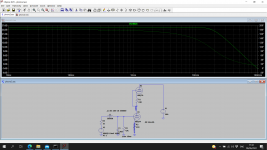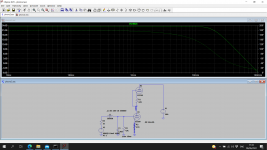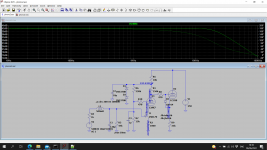Yes, Modest priced moving magnet cartridge. A normal 12AX7 stage gets pretty close to the limit on loading for most of these cartridges.
FWIW this is my phono stage. If I need more gain, 6N2 in front with 1k cathode resistors. 6N3 will fit without modification (instead of 6N1. Pinout is different of course). CMiller hasn't been an issue for me. Running Pickering XV-15/Stanton 680 cartridge. Tonar Banana (Ortofon Concorde) on the way though.

6N1 is pretty similar to 6922 isn't it? Gain would be somewhat on the low side for single stage so I might end up cascading anyway so I figured the 12AY7s that I have lying about ought to do just as well with less heater current. I do have some 6N1Ps so I could try those too. For some reason my 6N1P model does not work when configured as a CF. Not sure what the problem as Ayumi models are usually pretty good.For phono, I use 6N1, 6N2, or 6N3 depending on how much gain I need for first input. I leave out the P but I use Soviet tubes because they we're a good value 🙂
It looks like 6N2P has lower Cg-p than a 12AX7. Too bad I have 40 of the latter and none of the former. 🙂 6N3P looks a whole lot like a 12AY7.
I take that back. I just tried again and the model is working fine.
Last edited:
So you are cascading "totem poles" with no feedback right? What kind of gain are you getting before the EQ?
Me too, which is why I asked. I have a collection of MM carts, including a Grado white-something-or-other, a Stanton 681, a Pickering XV-15, and a Shure M35X, but lately I've been using an Audio Technica ATVM-95E. It's designed for a 150 to 200pF load. My tonearm wiring is about 30pF and the cable from the turntable is about 110pF, so that's 140pF right there. Add 200pF from a 12AX7 and I'm way over the limit. Even the 12AT7 I settled on adds 100pF or more, which is just over the maximum for that cartridge. I wound up trimming the preamp's high frequency response just a little by adding 150pF in parallel with the EQ network. It's not optimal, not at all. Measured through an inverse RIAA, it's down -1.5dB at 20kHz. But it sounds better to me that way than if I leave it with flat response. I blame that on a spike in response from the high Cin of the 12AT7 interacting with the cartridge inductance (550mH for the ATVM-95).mashaffer said:Yes, Modest priced moving magnet cartridge. A normal 12AX7 stage gets pretty close to the limit on loading for most of these cartridges.
The latest thing I'm trying is a hybrid cascode input phono preamp (LSK170 with a 6N6P on top). I just finished getting it together last week. It sounds very different from the RCA-style 12AT7-passiveEQ-12AT7-MOSFETfollower preamp I built over the winter. Being that it has a cascode input, the input capacitance is very low. I think that makes a difference with MM carts. The sound seems clearer, more 'contemporary', as opposed to 'warm' and 'vintage' sounding. The frequency response measures close to flat, with a 0.5dB bump up in the midbass while being down -0.5dB at 20kHz, so I don't think the difference I'm hearing is due to EQ error.
I figure vinyl has so many problems (noise, non-linearities) compared to the latest digital that you might as well use whatever sounds good to you and makes you happy. I do enjoy the warm and kind of soft presentation of the 12AX7 preamp.
6N1P is similar to 6DJ8... Less transconductance and higher heater draw, but similar gain. 6N2 is like 12AX7 but it has slightly bigger balls. 6N3 is like 5670...6N1 is pretty similar to 6922 isn't it? Gain would be somewhat on the low side for single stage so I might end up cascading anyway so I figured the 12AY7s that I have lying about ought to do just as well with less heater current. I do have some 6N1Ps so I could try those too. For some reason my 6N1P model does not work when configured as a CF. Not sure what the problem as Ayumi models are usually pretty good.
It looks like 6N2P has lower Cg-p than a 12AX7. Too bad I have 40 of the latter and none of the former. 🙂 6N3P looks a whole lot like a 12AY7.
I take that back. I just tried again and the model is working fine.
Anyone who wants a PCB of the above circuit that I shared to try can send a message... I have a few to spare and it would be nice to get opinions.
A VHF valve such as an ECC88/6DJ8 may be a better option in the first stage rather than 12AX7/12AY7 both on noise an miller cap. If you simulate with some cartridge inductance. I've never built a phono and sadly don't have any records. Just reading the book on this. The LSK170 is something I have used. I used a LTP with LSK170/12AX7 as the front end of a PA - quite different.
So simulation with some inductance shows that the 12ax7 solution is not OK in that the capacitance that needs adding after the pickup is lower than the cable capacitance (100pF). Kodabmx using a 6N1P or 6DJ8 is much better - the top valve adding good HT rejection which is critical with the eq.
Attachments
Allen Wright favored using a 6DJ8 as the top tube in a hybrid LSK170-triode cascode.
I believe you can use just about anything for the top triode, as it's the FET that does the work in that circuit.
A cascode made of two 6DJ8 triodes is also a popular choice.
I believe you can use just about anything for the top triode, as it's the FET that does the work in that circuit.
A cascode made of two 6DJ8 triodes is also a popular choice.
Yep. The drain current can be anywhere between 2.6ma and 20ma for the 2sk170 for Vgs=0v so the bias needs to be less than the 2.6ma value else the worst case JFET will start to have a positive Vgs voltage. So I went for a 12ax7 rather than a 6dj8 and .5ma. However with a 6DJ8 I would be looking for at least 5ma for Vgs = 0v so would choice something else. It also make for a big spread in R2. You could put a couple of matched JFETs with separate source resistors in parallel. That's meant to make the NF even better. 2N5485 or J112 with a 6DJ8. Gain is lower but can bypass the source resistor if needed. Don't know about the NF for the 2N5485 though. Lots of choice - all been done before.
Last edited:
MerlinB has a nice cascode circuit in his High Fidelity Valve Preamps book, using an LSK170 with a 12AU7 on top. The grid of the 12AU7 is grounded, with the JFET in its cathode, and an unbypassed resistor of about 75R for the JFET's source load. Since a 12AU7 can work at about Ia = 3mA with Vk of about 8V to 10V, there's enough room in there for the LSK170 to operate self-biased. That's one less RC network in the circuit, which is a good thing inside a NFB loop.
Last edited:
- Home
- Amplifiers
- Tubes / Valves
- Anything wrong with this.



